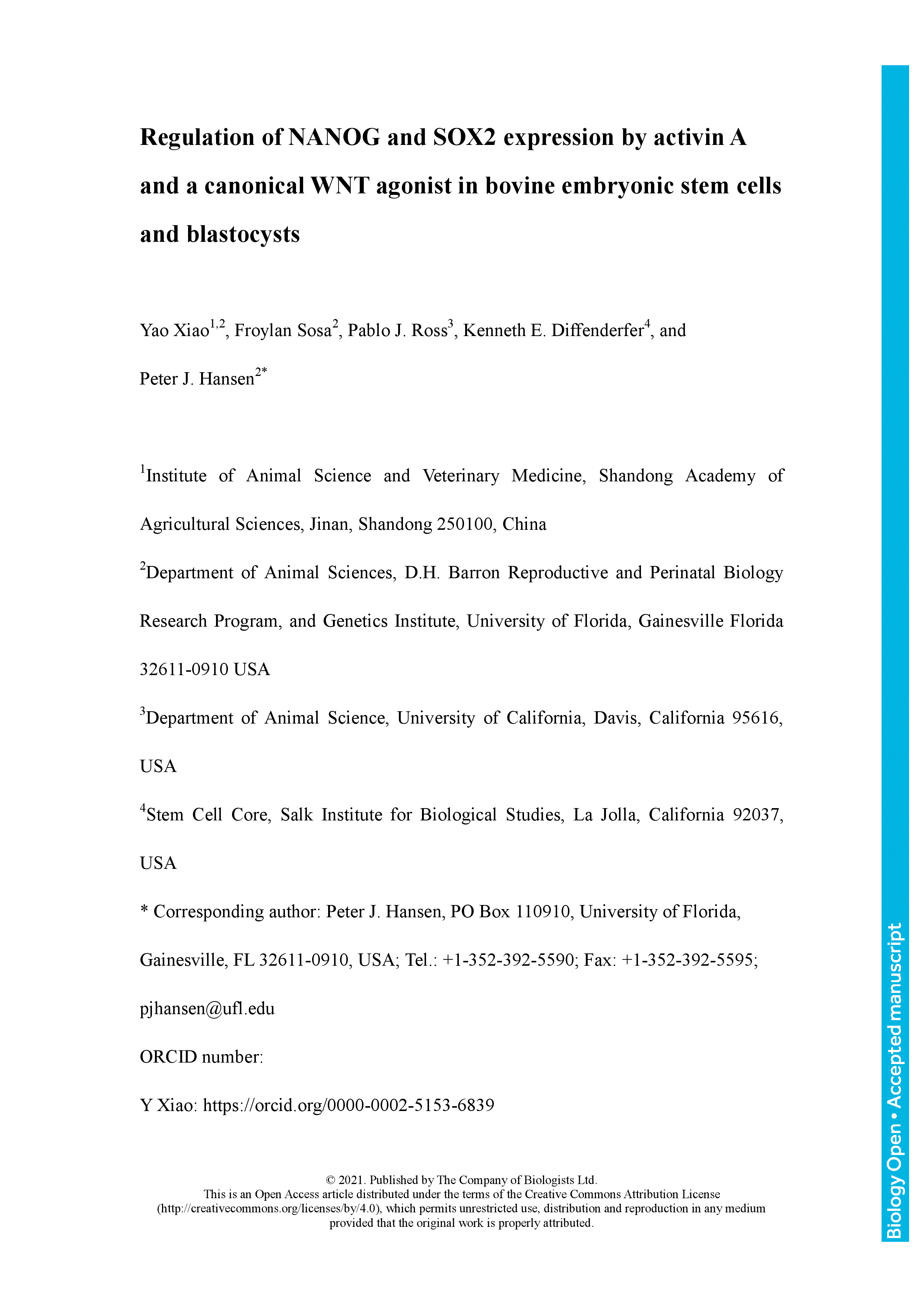Bovine embryonic stem cells (ESC) have features associated with the primed pluripotent state including low expression of one of the core pluripotency transcription factors NANOG. It has been reported that NANOG expression can be upregulated in porcine ESC by treatment with activin A and the WNT agonist CHIR99021. Accordingly, it was tested whether expression of NANOG and another pluripotency factor SOX2 could be stimulated by activin A and the WNT agonist CHIR99021. Immunoreactive NANOG and SOX2 were analyzed for bovine ESC lines derived under conditions in which activin A and CHIR99021 were added singly or in combination. Activin A enhanced NANOG expression but also reduced SOX2 expression. CHIR99021 depressed expression of both NANOG and SOX2. In a second experiment, activin A enhanced blastocyst development while CHIR99021 treatment impaired blastocyst formation and reduced number of blastomeres. Activin A treatment decreased blastomeres in the blastocyst that were positive for either NANOG or SOX2 but increased those that were CDX2+ and that were GATA6+ outside the inner cell mass. CHIR99021 reduced SOX2+ and NANOG+ blastomeres without affecting the number or percent of blastomeres that were CDX2+ and GATA6+. Results indicate activation of activin A signaling stimulates NANOG expression during self-renewal of bovine ESC but suppresses cells expressing pluripotency markers in the blastocyst and increases cells expressing CDX2. Actions of activin A to promote blastocyst development may involve its role in promoting trophectoderm formation. Furthermore, results demonstrate the negative role of canonical WNT signaling in cattle for pluripotency marker expression in ESC and in formation of inner cell mass and epiblast during embryonic development.
Regulation of NANOG and SOX2 expression by activin A and a canonical WNT agonist in bovine embryonic stem cells and blastocysts
- Award Group:
- Funder(s): National Institutes of Biomedical Innovation, Health and Nutrition
- Award Id(s): R01 HD088352
- Funder(s):
- Award Group:
- Funder(s): U.S. Department of Agriculture
- Award Id(s): 2017-67015-26452
- Funder(s):
Currently Viewing Accepted Manuscript - Newer Version Available
- Split-screen
- Views Icon Views
- Open the PDF for in another window
-
Article Versions Icon
Versions
- Version of Record 29 November 2021
- Accepted Manuscript 13 October 2021
- Share Icon Share
-
Tools Icon
Tools
- Search Site
Yao Xiao, Froylan Sosa, Pablo J. Ross, Kenneth E. Diffenderfer, Peter J. Hansen; Regulation of NANOG and SOX2 expression by activin A and a canonical WNT agonist in bovine embryonic stem cells and blastocysts. Biol Open 2021; bio.058669. doi: https://doi.org/10.1242/bio.058669
Download citation file:
Advertisement
Read & Publish Open Access publishing: what authors say

We have had great feedback from authors who have benefitted from our Read & Publish agreement with their institution and have been able to publish Open Access with us without paying an APC. Read what they had to say.
Biology Open 2023 - a year in review

In this Editorial, BiO Editor-in-Chief Dan Gorelick reviews the journal's performance in 2023 and discusses his plans to improve author experience.
The Forest of Biologists
Our Publisher Claire Moulton recently visited the two Woodland Trust UK sites where we are planting new native trees for published Research and Review papers and protecting ancient woodland on behalf of our peer reviewers.
A Year at the Forefront

This series of Review articles aims to highlight the key discoveries, technological innovations, new resources and new hypotheses that have made an impact in a specific biological field during the past year. This publishing opportunity is available to early-career researchers, without a publication charge. Find out about eligibility and how to submit a proposal.
How we support early-career researchers

Biology Open, its sister journals and its not-for-profit publisher, The Company of Biologists, support early-career researchers in numerous ways, helping them grow their network and raise their profile. Find out what we can do to support you.



